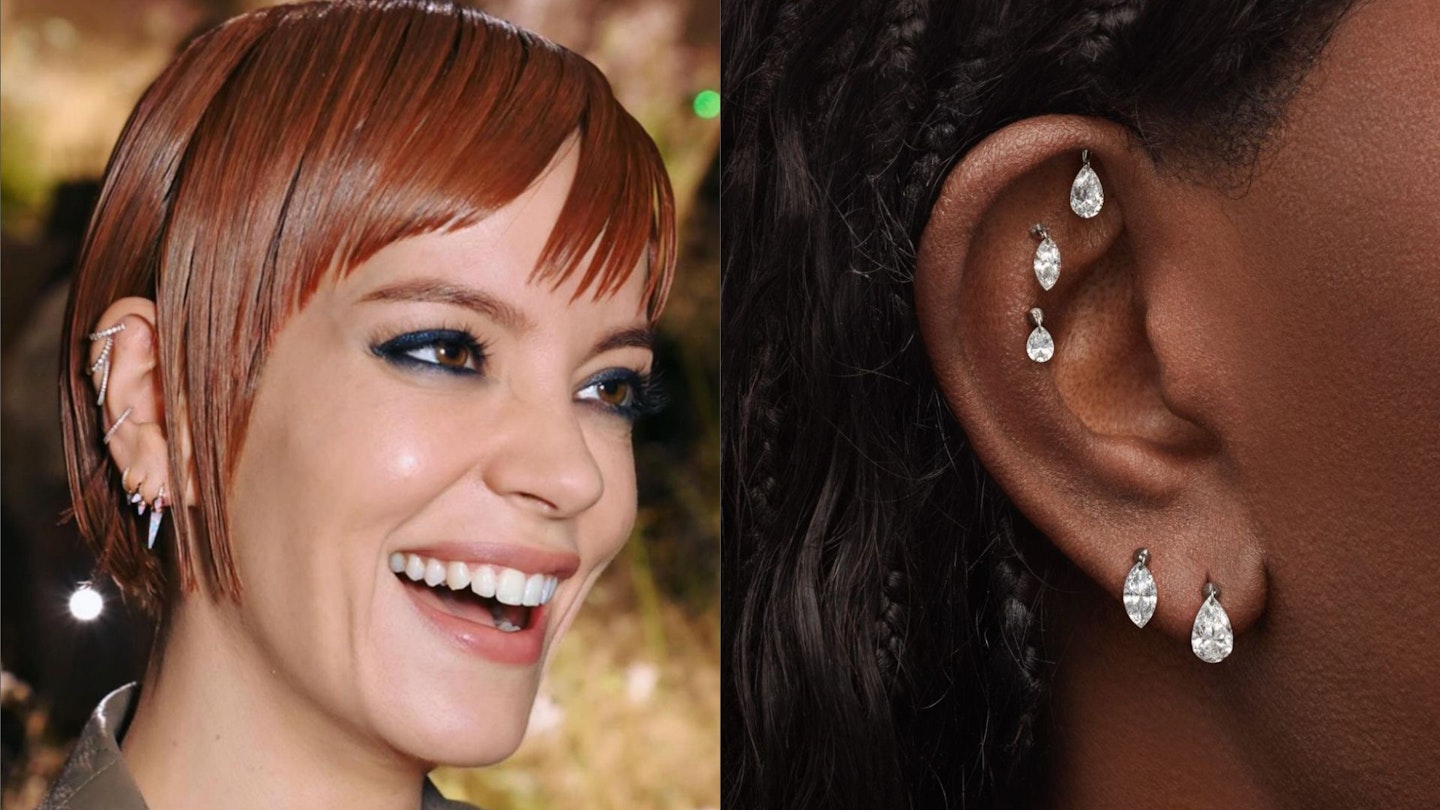Ear piercings never go out of style, but there’s a lot to consider before you go under the needle – which one to get, whether it hurts, which is the most painful piercing on the menu, and what that dodgy smell is... Thankfully, we've done the hard work for you by curating a definitive guide to ear piercings, starting off with different piercing placements and what they're called (we've made a chart for that), as well as the pain factor associated with each (we've got a chart for that, too). Plus, we've enlisted the help of piercing expert Maria Tash as well as ear stylist Hazel, AKA the Botanical Piercer, who break down everything you need to know.
Ear Piercing Basics
Ear piercings encompass a host of different placements (see our chart below which illustrates where you can find each of them). If you find ear piercings hard identify, as a rule of thumb, remember ear piercings can be grouped into three distinguishable categories: lobe piercings, which pertain to anything in the lobe; outer ear piercing, which account for piercings like the tragus, the industrial and the snug; and inner ear piercings, like theanti-tragus piercing, the rookor daith piercing.
Ear Piercing Chart
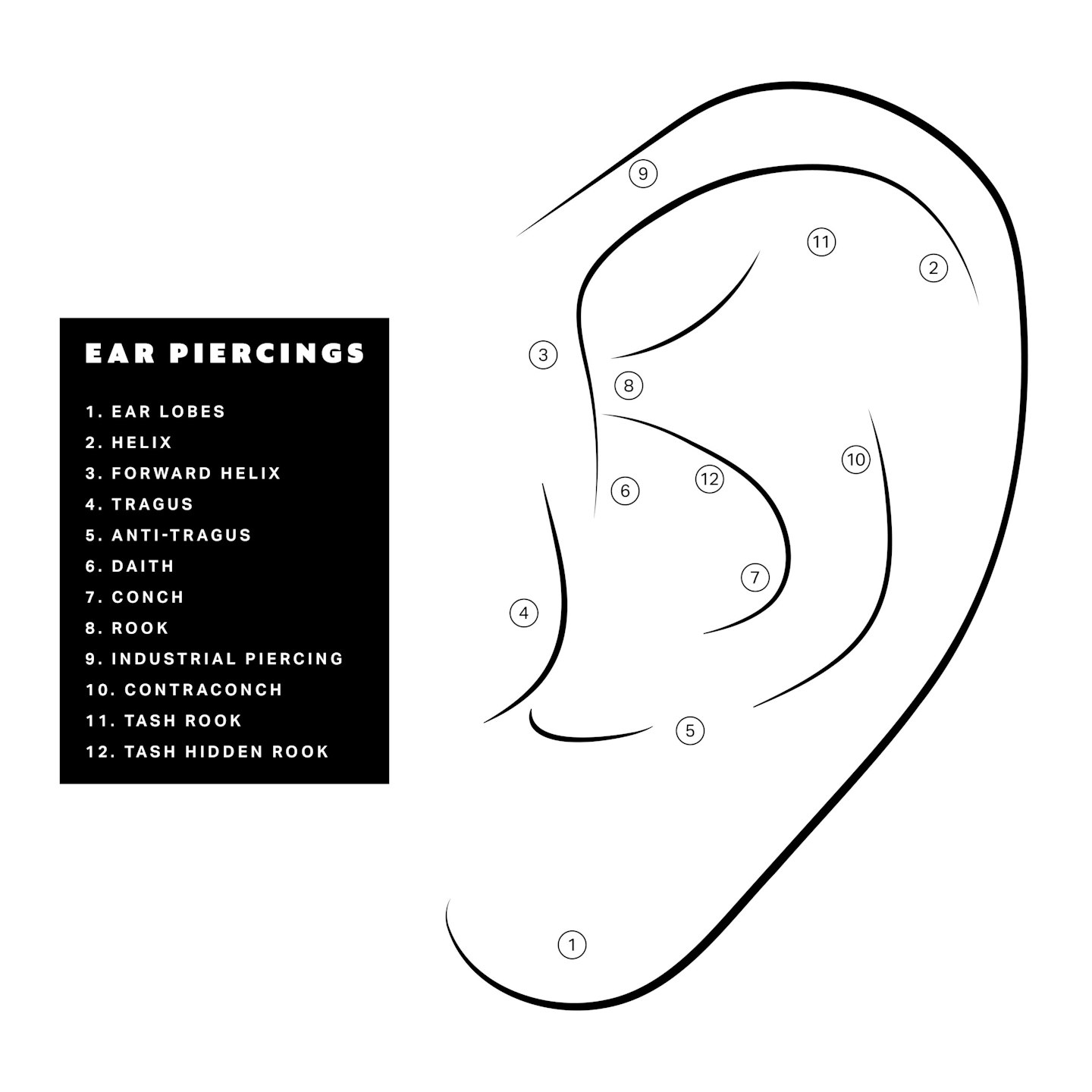
Which Ear Piercing Looks Best?
If anyone knows how to find the right piercing for you, it's Maria Tash. Her expert piercing services in London department stores Liberty and Harrods, and beautiful gem-set, gold-plated jewellery has earned her status as a world-renowned piercer, loved by celebs and influencers alike.
Tash points out that the lobe piercing will always reign supreme due to its cultural acceptance and quick healing time. However, she says that more innovative lobe piercings like stacked lobe piercings are becoming fashionable for those who have a low pain threshold and want a quick healing time but are seeking a more artful look. 'I just introduced the Tash Lobe, which I think will be popular for a more avant garde set. It is in the lobe, but located in the unusual spot where it abuts the cheek, thereby creating a completely new look not seen before,' Tash explains.
As for the most dramatic ear piercings of 2024? 'The contraconch and stacked lobes over hole two and three will be popular. The contraconch, first done by our lead piercer at our Liberty London location, is a beautiful and novel piercing that is a bit more unique than the Tash rook plane of tissue. It is very alluring to have a subtle movement of studs placed in this region. Stacked lobes are fun for the quick healing time, and they look more interesting when not over the first lobe.'
How Long Do Ear Piercings Take To Heal?
The healing process really depends on the type of piercing. The ear lobe healing time is around four to six weeks. Outer cartilage piercings like the helix, daith or tragus piercing will be more like 12 weeks but can last up to six months - remember, everyone is different. It's best not to rush changing the jewellery and ensuring it is fully healed before you do, because it can agitate the piercing.
Ear piercings are not permanent; if piercings are left out long enough, they will usually close up. The piercer will be able to advise on the approximate healing time for your particular piercing.
Given enough time, an ear piercing will usually heal/close without leaving a scar although this will differ for everyone and it's possible that a mark of where the hole used to be will never go. If you wear heavy earrings or stretch the holes in anyway, it will make it more difficult for the hole to heal and is more likely to leave a scar.
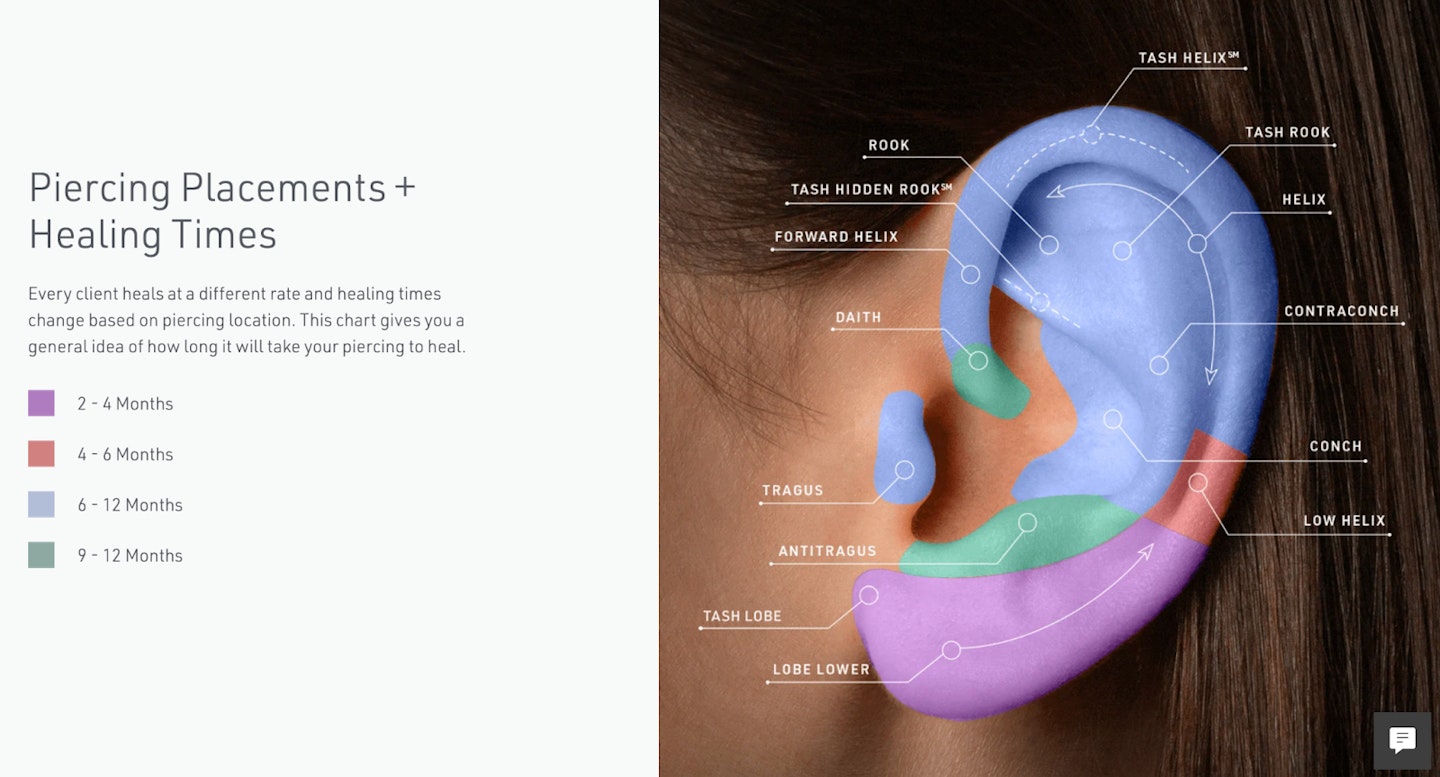
Types Of Ear Piercings
There are lots of options, so if you are considering a new ear piercing first begin to think what kind of look you want. You'll want to think about the type of earring you like to wear (hoops are better for standard piercings; studs for helix); how good you are with pain and how many piercings you want to have in total so your piercer can space them out. If you don’t have any, then of course your earlobes are a good place to start but if you've already got that, you might want to opt for another part of the ear. Here's a list of all the different types of ear piercings to help inspire you...
1. Ear Lobes
The standard lobe piercing refers to the lower section of the ear. Many combinations of lobe piercings are possible to create a unique look and this tends to be the least painful out of all ear piercings, meaning it's great for anyone just starting off in the piercing game. Tash says: 'The lobe is the soft lower section of the ear. It is a versatile location to experiment with many different jewellery.'
Pain level: 1/5
Healing time: 6-8 weeks
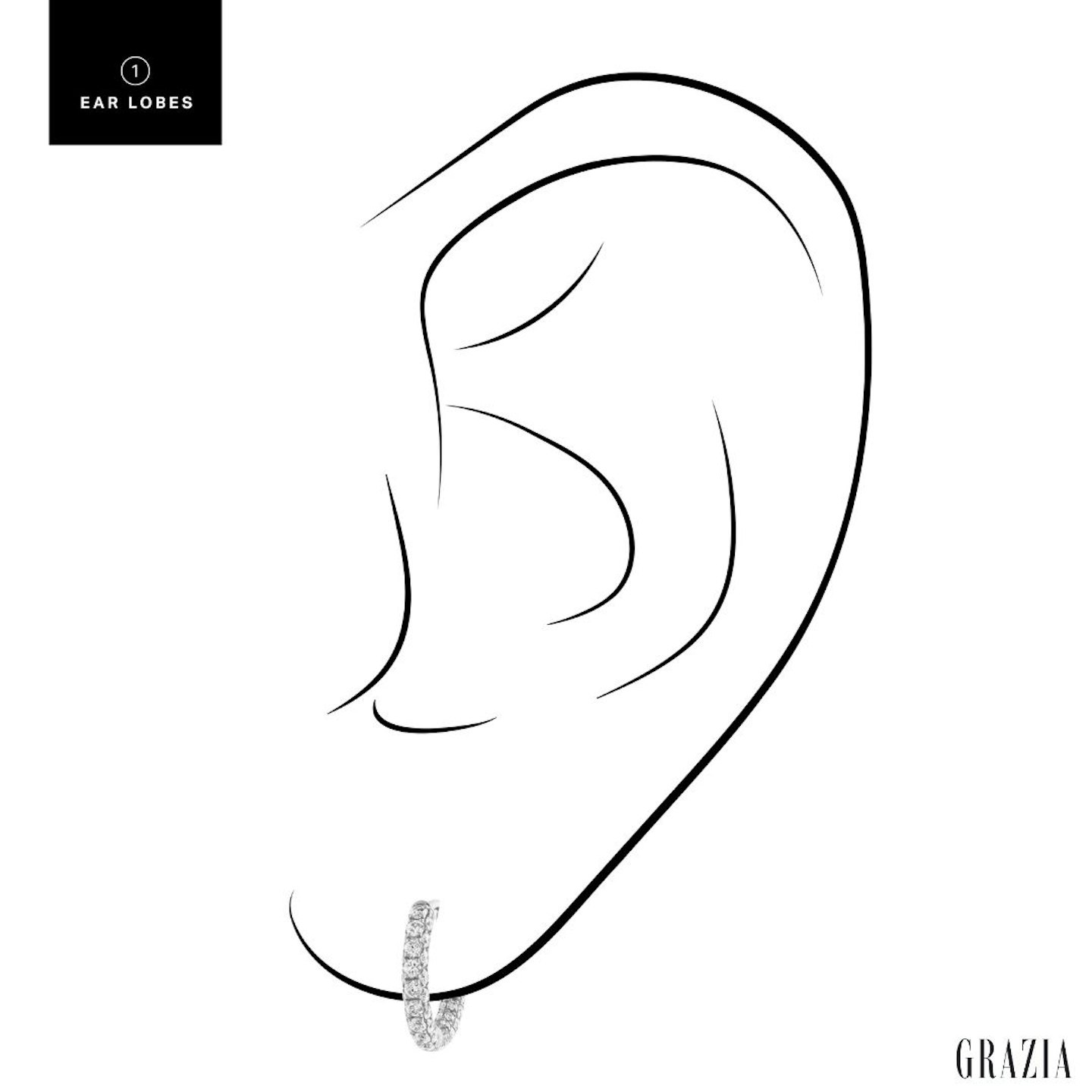

www.farfetch.com
A dainty addition to the lobes, made from recycled 14kt yellow gold.
2. Helix
The helix piercing can be found around the upper and outer cartilage. 'This placement is located along the inside ridge of the upper ear between the forward helix and the lobe. A wide range of jewellery looks striking in this popular piercing location,' says Tash. The placement allows for a multitude of looks, from delicate hoops or a chance to enjoy the flat piercing trend and is perfect for those who want to try a bold style.
Pain level: 3/5
Healing time: 6-9 months
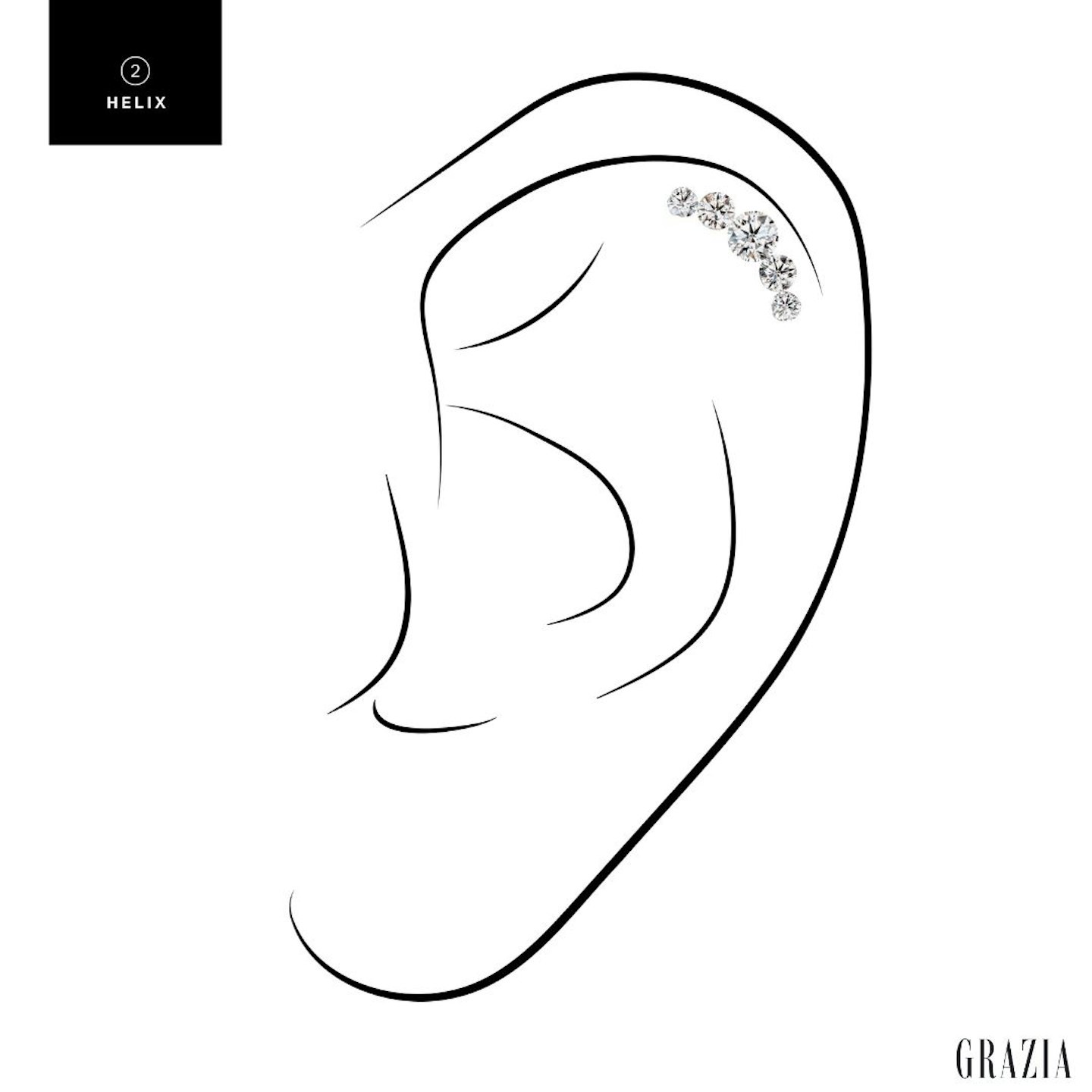
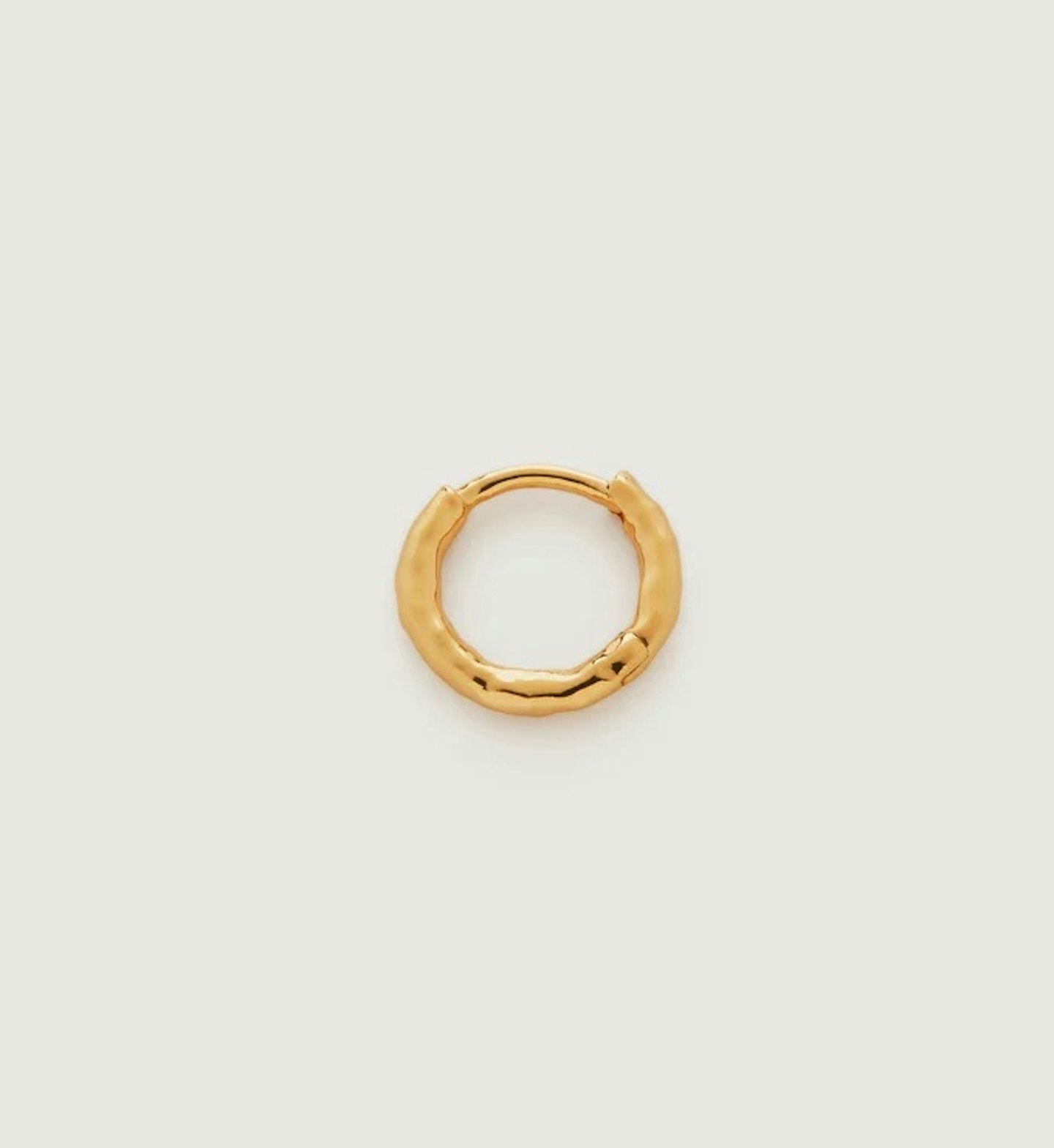
www.monicavinader.com
Made from 18k gold vermeil, this dainty hoop is a subtle yet pretty addition to any helix piercing.
3. Forward Helix
The forward helix is the frontal part of the ear that follows the helix and is not for the faint hearted given its tender location. If you do this piercing, you'll want to think carefully about the type of earring too. 'Picking up where the helix leaves off, the forward helix is the convex flap of skin that helps connect the ear to the head,' says Tash. 'Several petite studs make for an interesting curation in this spot.'
Pain level: 4/5
Healing time: 3-9 months
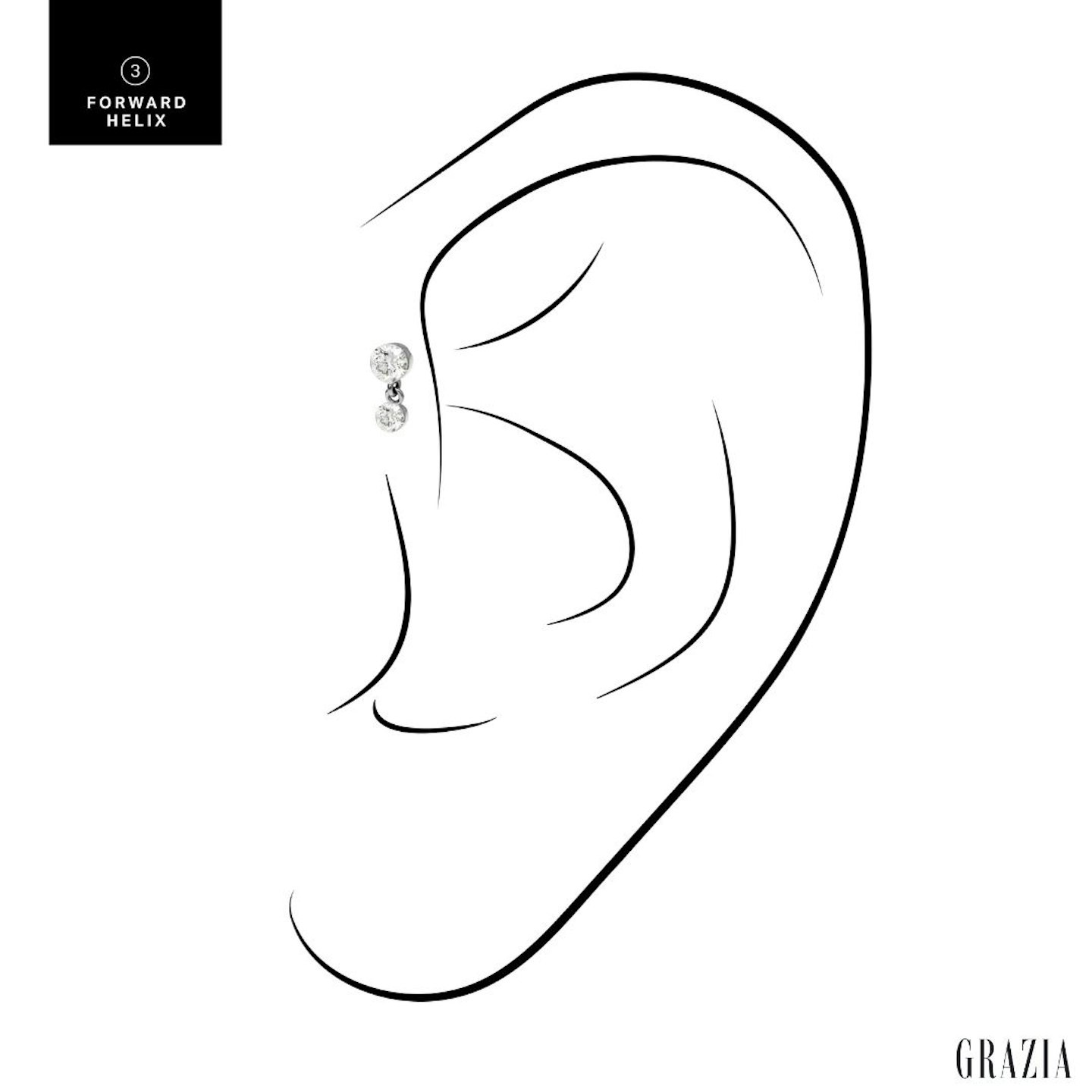
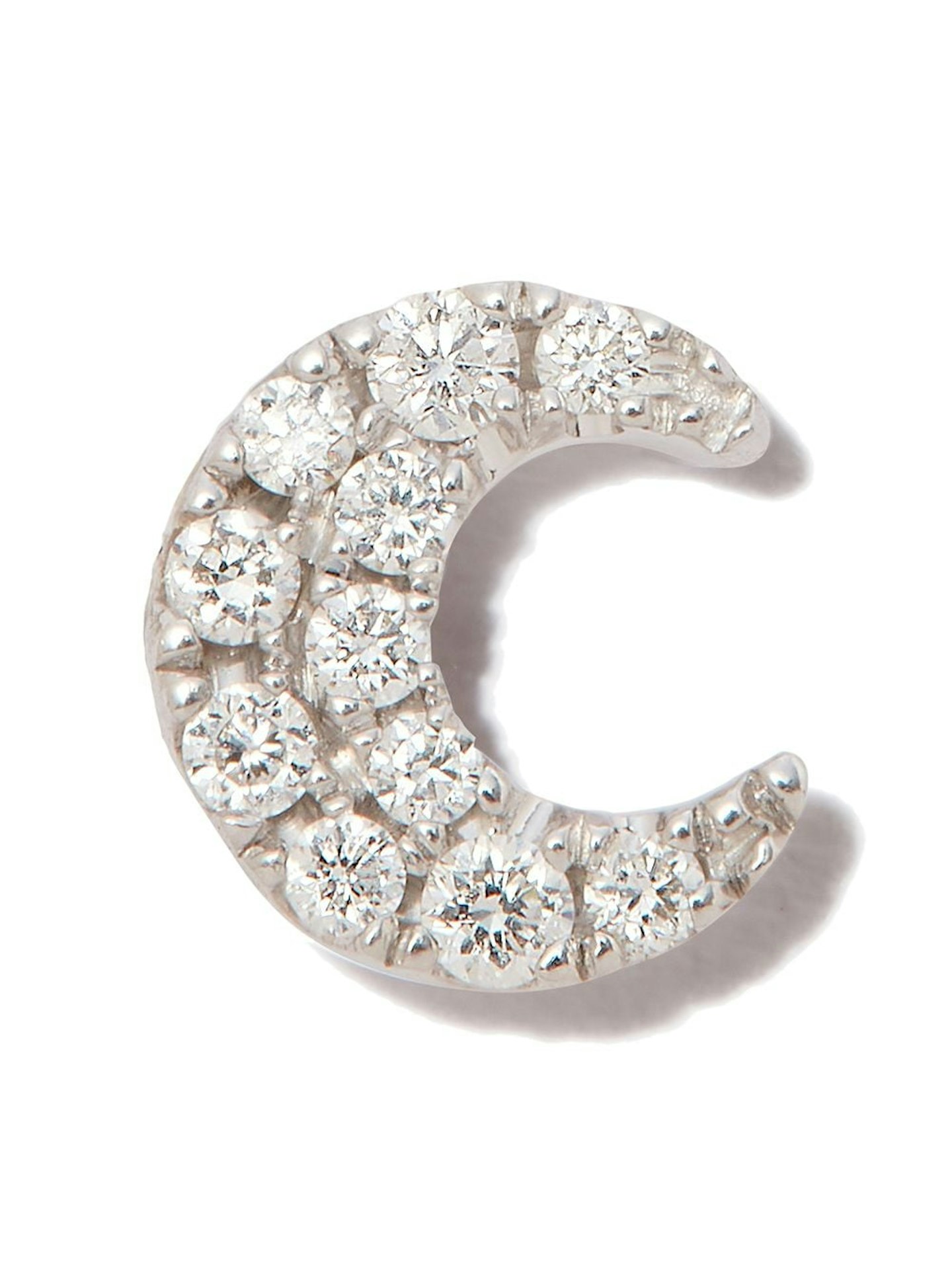
www.matchesfashion.com
This stunning 18kt white gold stud is the perfect stud accessory for a healed forward helix.
4. Tragus
The tragus is the flap of skin that sits in front of the ear canal. Due to this location jewellery in the tragus can be seen when viewing the face straight-on, thanks to its eye catching nature Tash advises 'showcasing smaller rings and studs in this intriguing placement.'
Pain level: 3/5
Healing time: 6-9 months
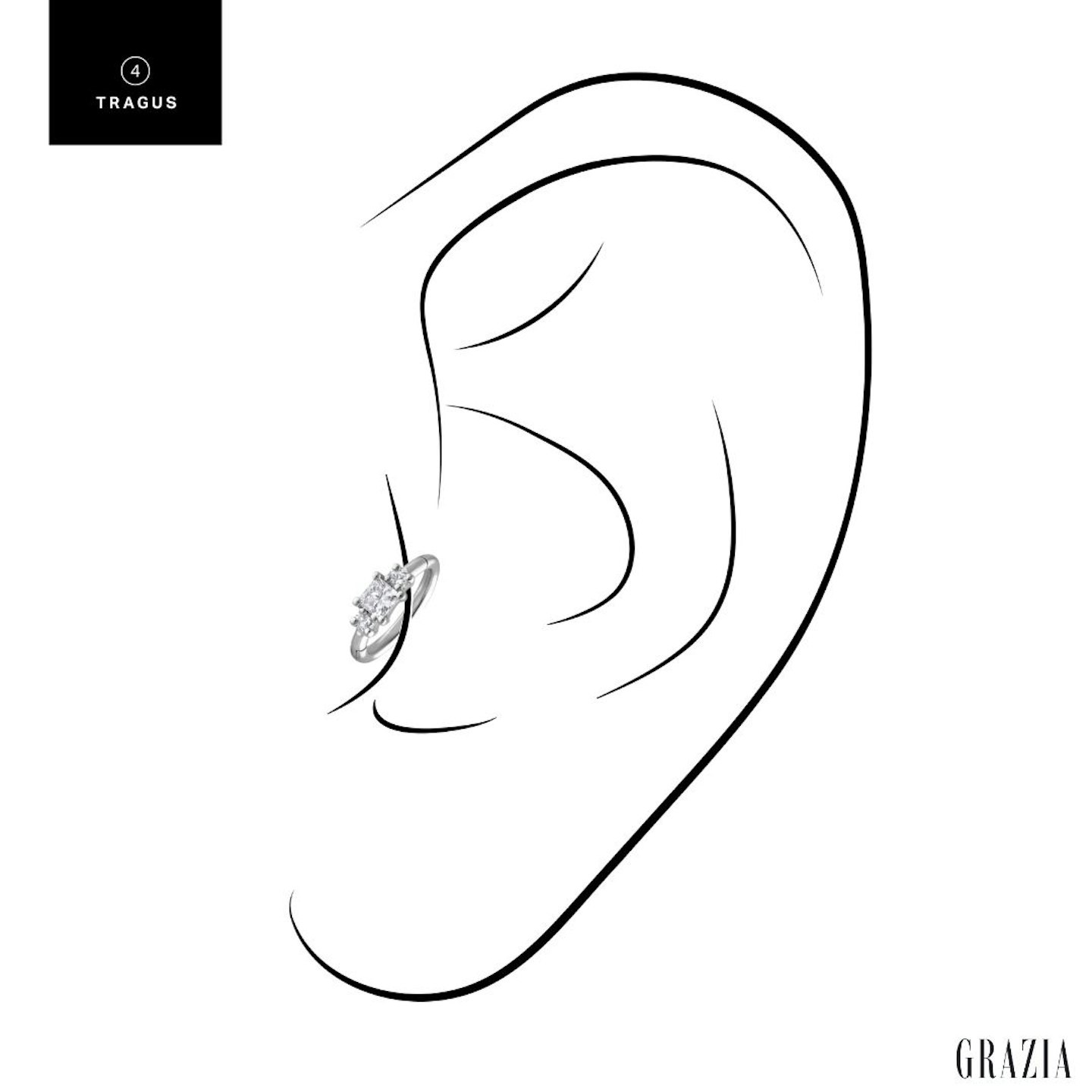
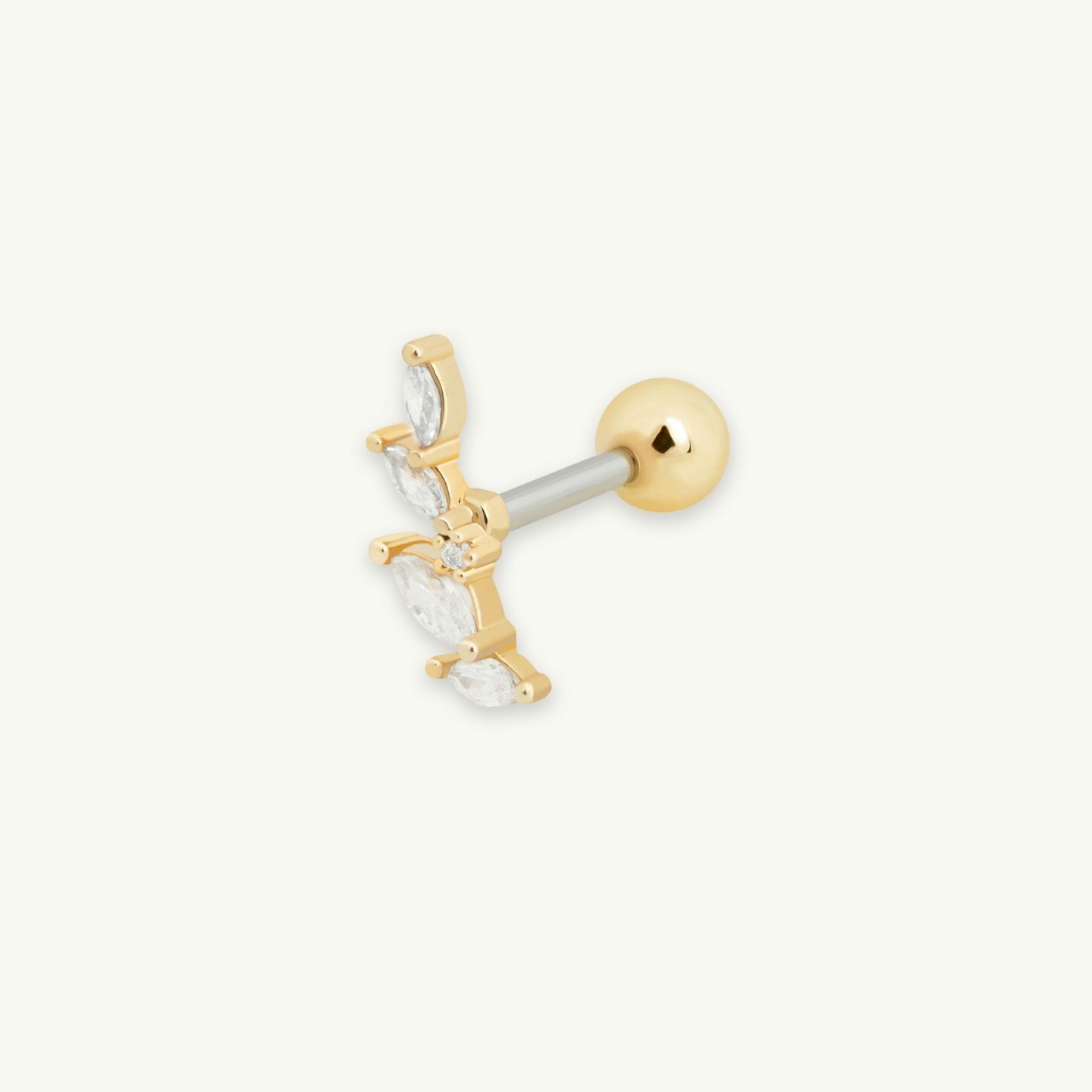
www.astridandmiyu.com
Perfectly suited for any healed piercing. Made in sterling silver and gold plated with a screw ball backing.
5. Anti-Tragus
'The anti-tragus is the ridge of cartilage above the lobe and opposite the tragus,' says Tash. 'This uncommon placement is the perfect spot for petite hoops and rings.' Due to this being a type of cartilage piercing, you can expect moderate levels of pain and it's worth noting that everyone's anatomy is different but those who do have enough of a triangular ridge cartilage to work with would be an ideal candidate for the anti-tragus piercing. Those that don't will want to give this one a miss or pierce the upper lobe instead for a similar look.
Pain level: 4/5
Healing time: 9 months - 1 year
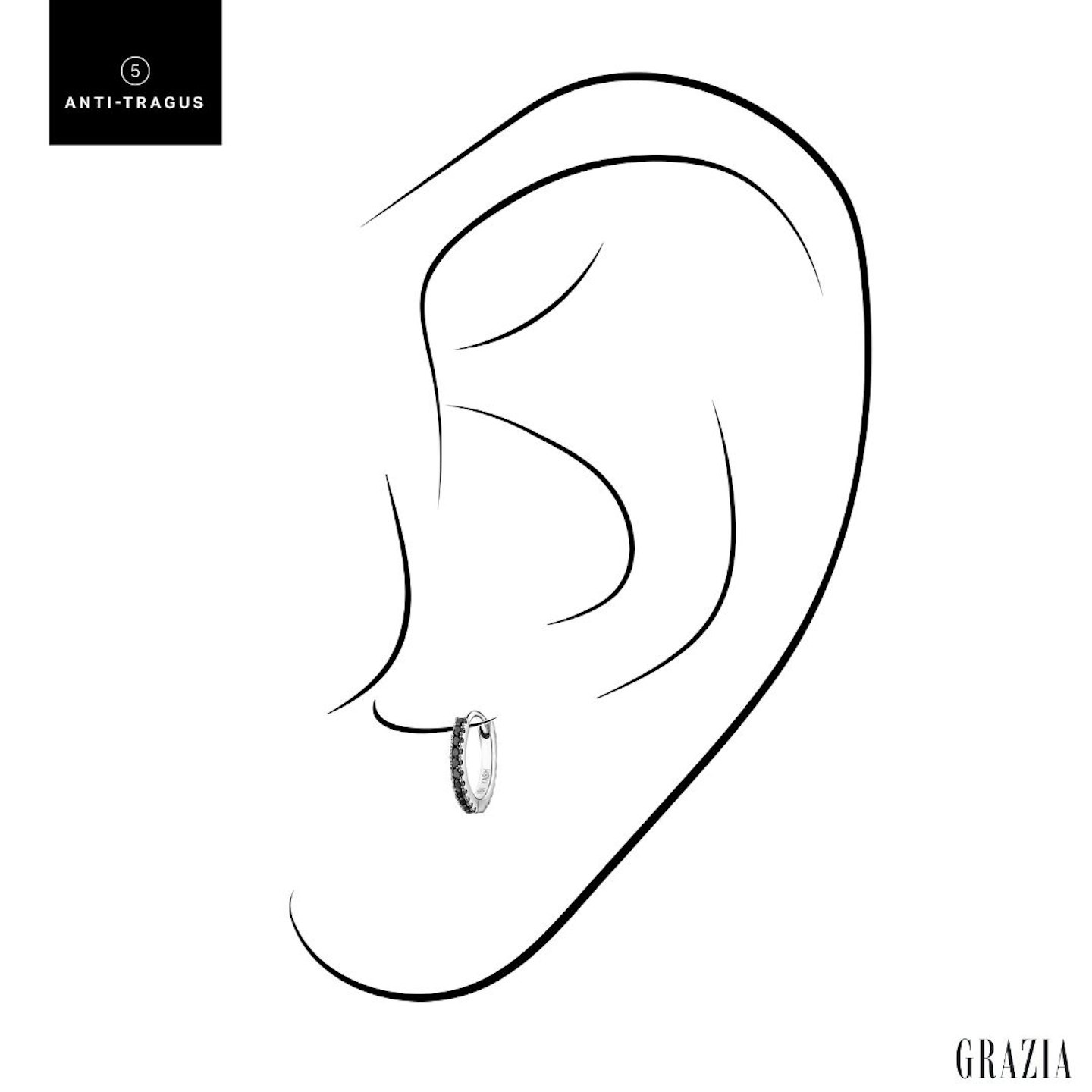
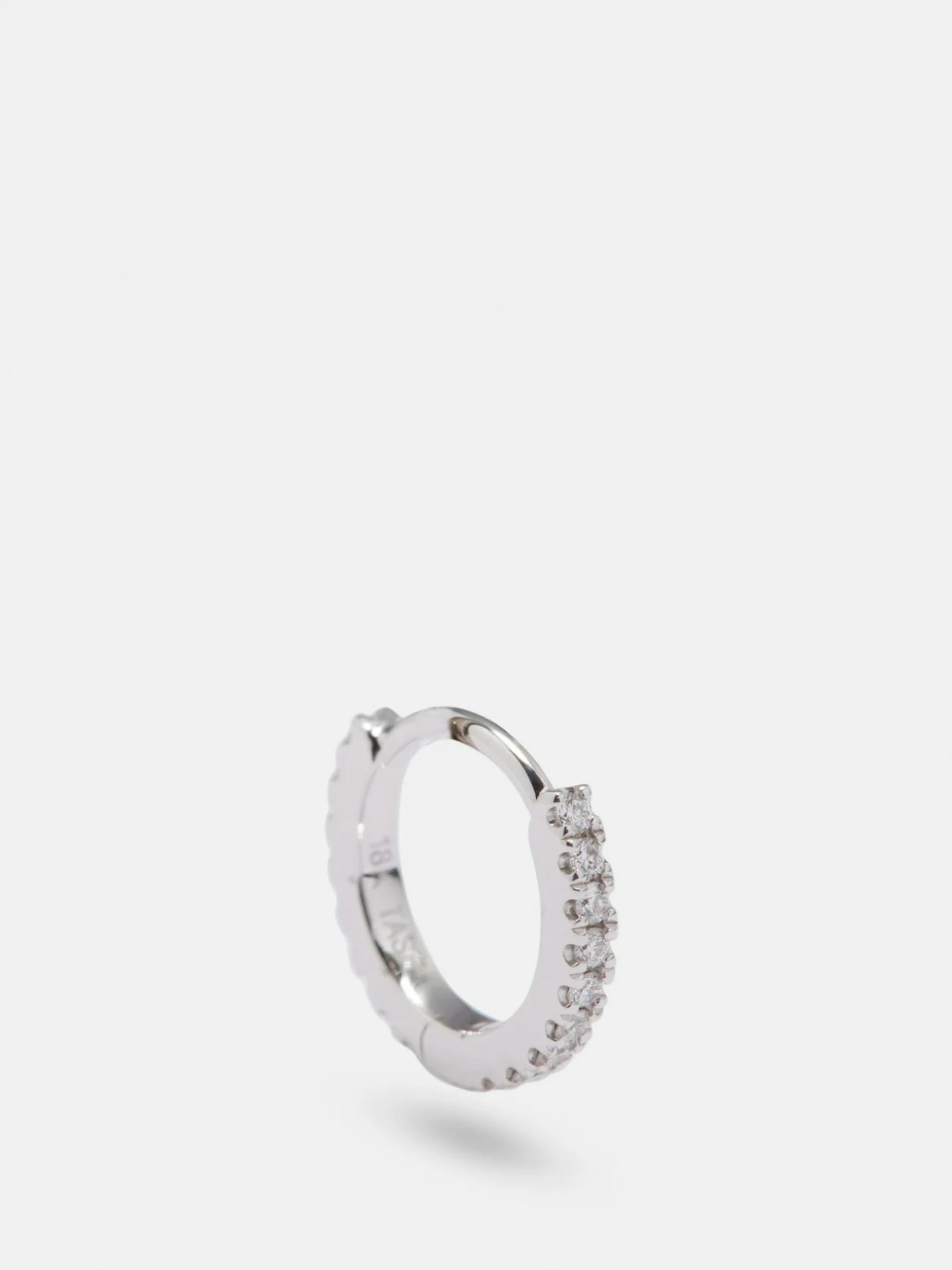
www.matchesfashion.com
This diamond hooped ring features white diamonds and would work perfectly in any earring stack.
6. Daith
'The daith is positioned in the inner fold of the ear,' Tash explains, of the point found between the tragus and rook. 'This bold placement is perfect for showcasing a ring.' And yet, thanks to its positioning it can be tucked away when looking from front on, making it subtle yet effective when needed.
The Daith has also become popular of late because many believe it can serve a medical purpose. Interventional pain doctor, Dr Thomas Cohn, explains: 'Some people who have received a daith piercing have coincidentally found improvement with their migraine headaches. It is not universal, and it is has not been studied formally. The correlation is based on the success for some people with acupuncture in the same region of the daith piercing. If a person enjoys ear piercings and suffers from frequent headaches, it may be worthwhile to consider getting this spot pierced.'
Pain level: 4/5
Healing time: 6-9 months
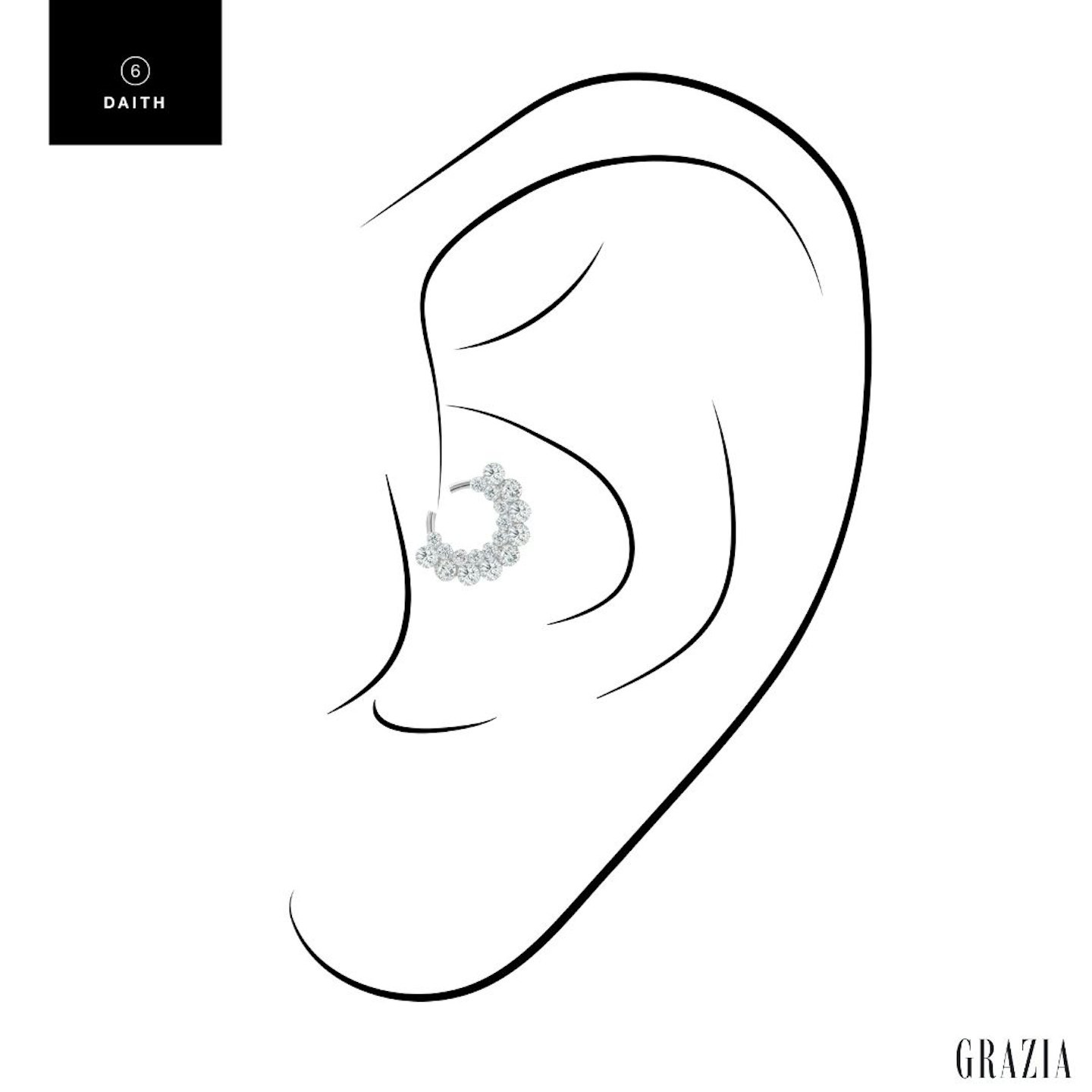
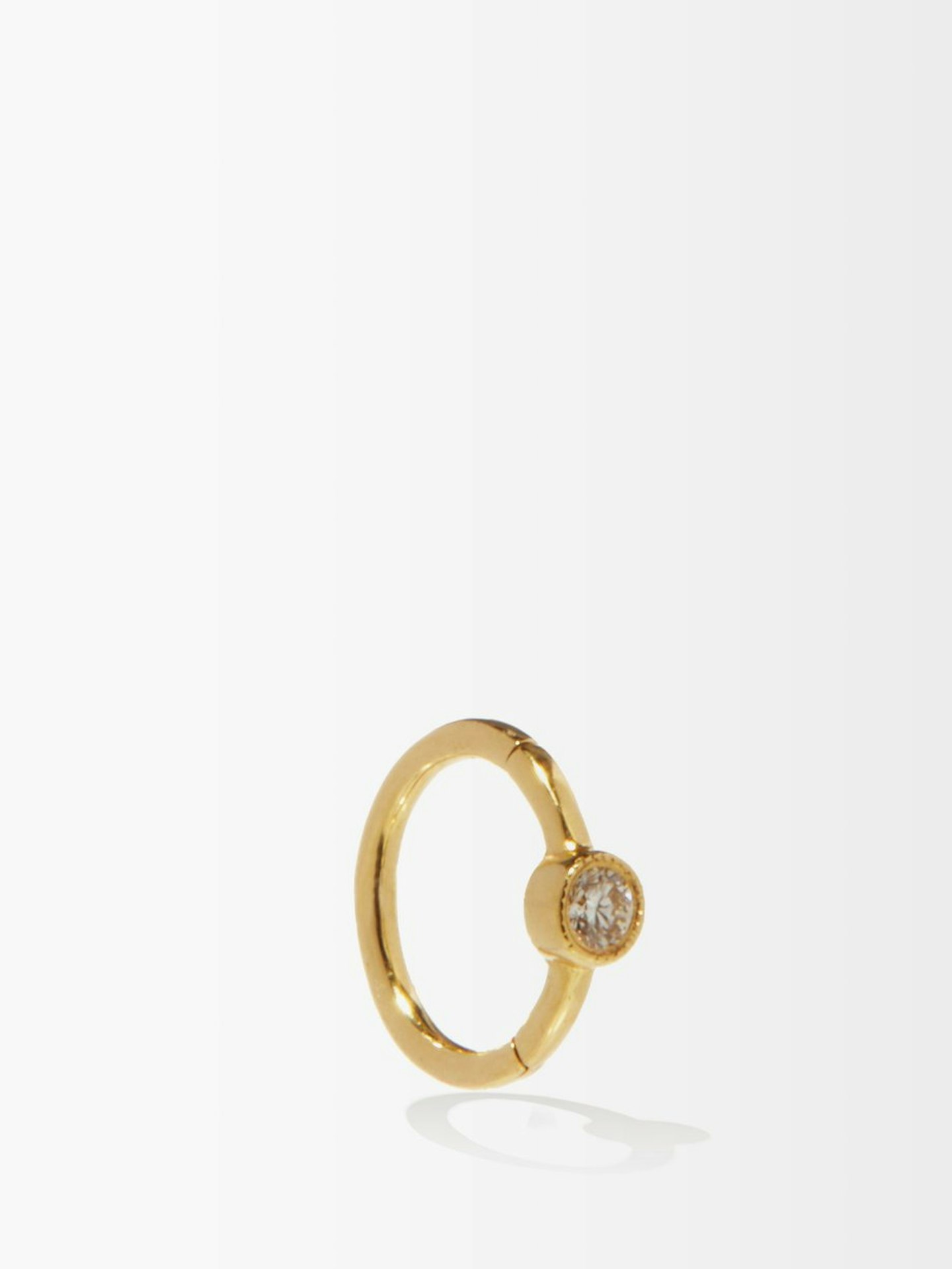
www.mytheresa.com
This huggie earring is made from a thicker gauge suitable for upper-earrings. It's also nickel-free and made from hypoallergenic 18kt gold (so no discomfort here).
7. Conch
'The Conch is nestled in the middle part of the inner ear,' says Tash. 'Loop rings across both the inner and outer ear for a bold look. Alternatively, the area can provide a great frame for studs'. Depending on the look you're seeking to achieve, you could dial the piercing up or down as Tash points out with the style of earring you wear, and therein lies the appeal of it.
Pain level: 2/5
Healing time: 3-9 months
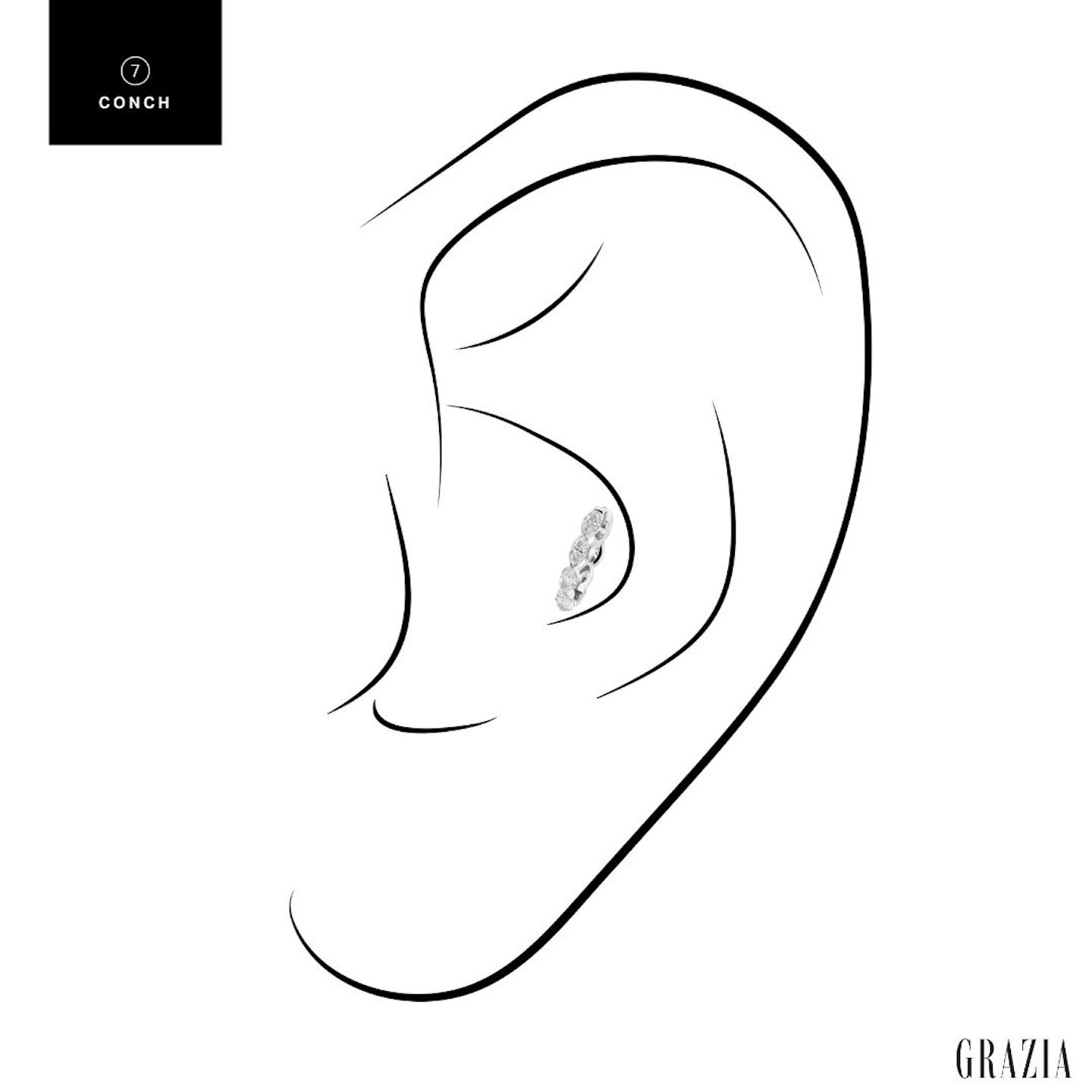
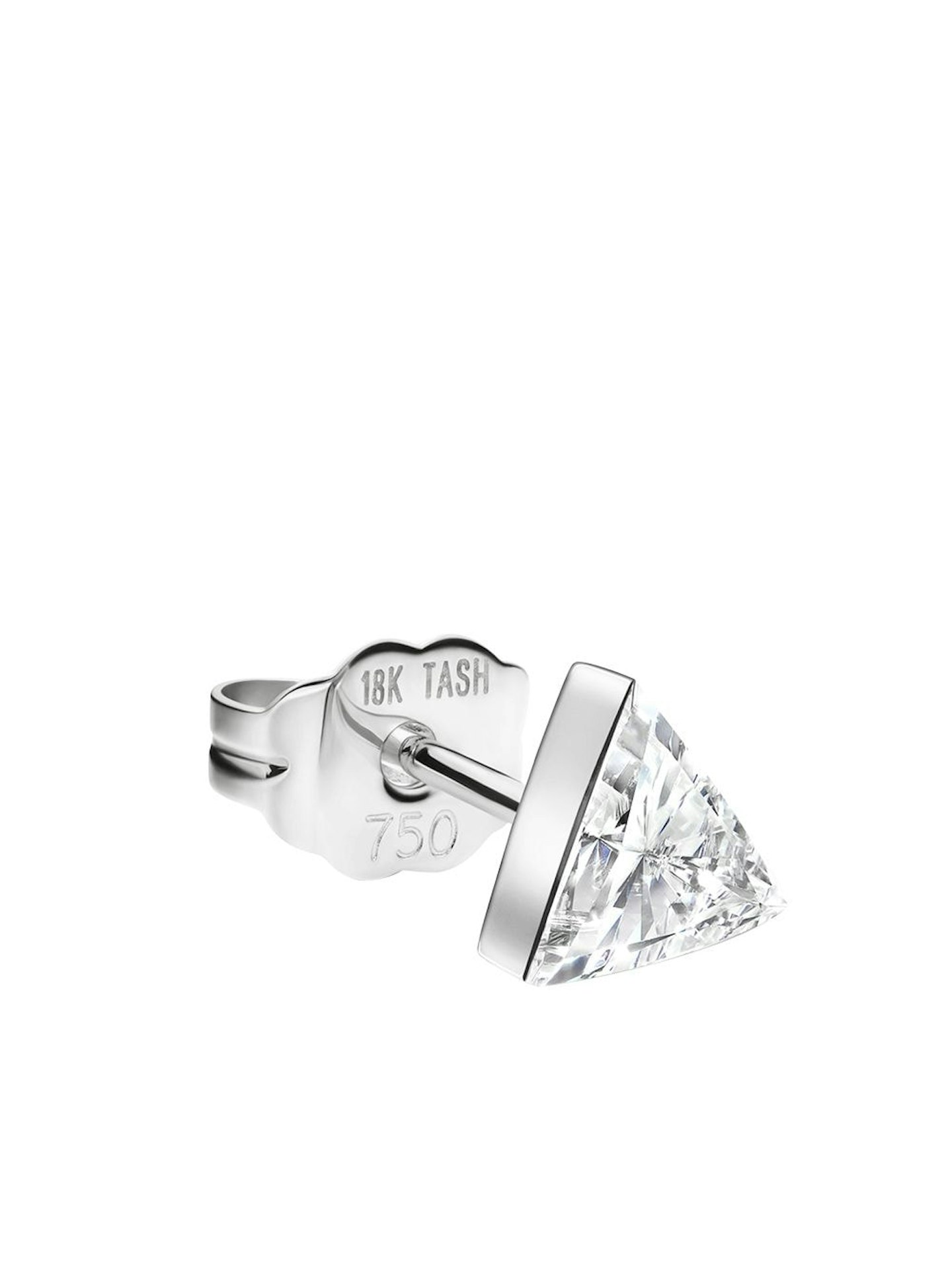
www.farfetch.com
A triangle diamond stud earring, made to sit comfortably on the skin.
8. Rook
The rook piercing is a vertical piercing which 'goes through the ridge of the inner ear closest to the head. Rings and curved barbells are ideal for this placement,' says Tash. This one passes through a usually thick piece of cartilage, so will be painful. However, the unique placement may lure those looking for an unusual style of piercing.
Pain level: 5/5
Healing time: 3-10 months
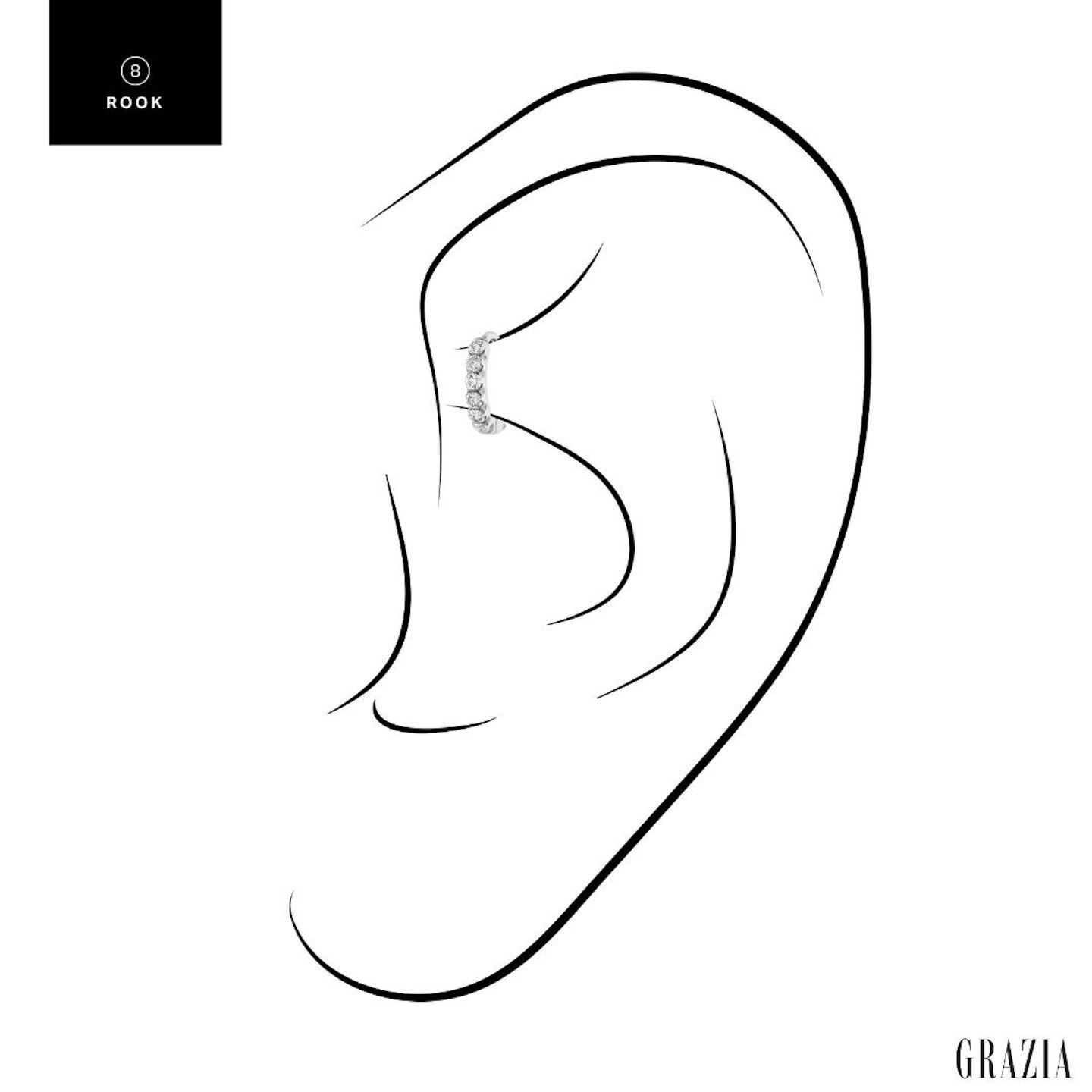
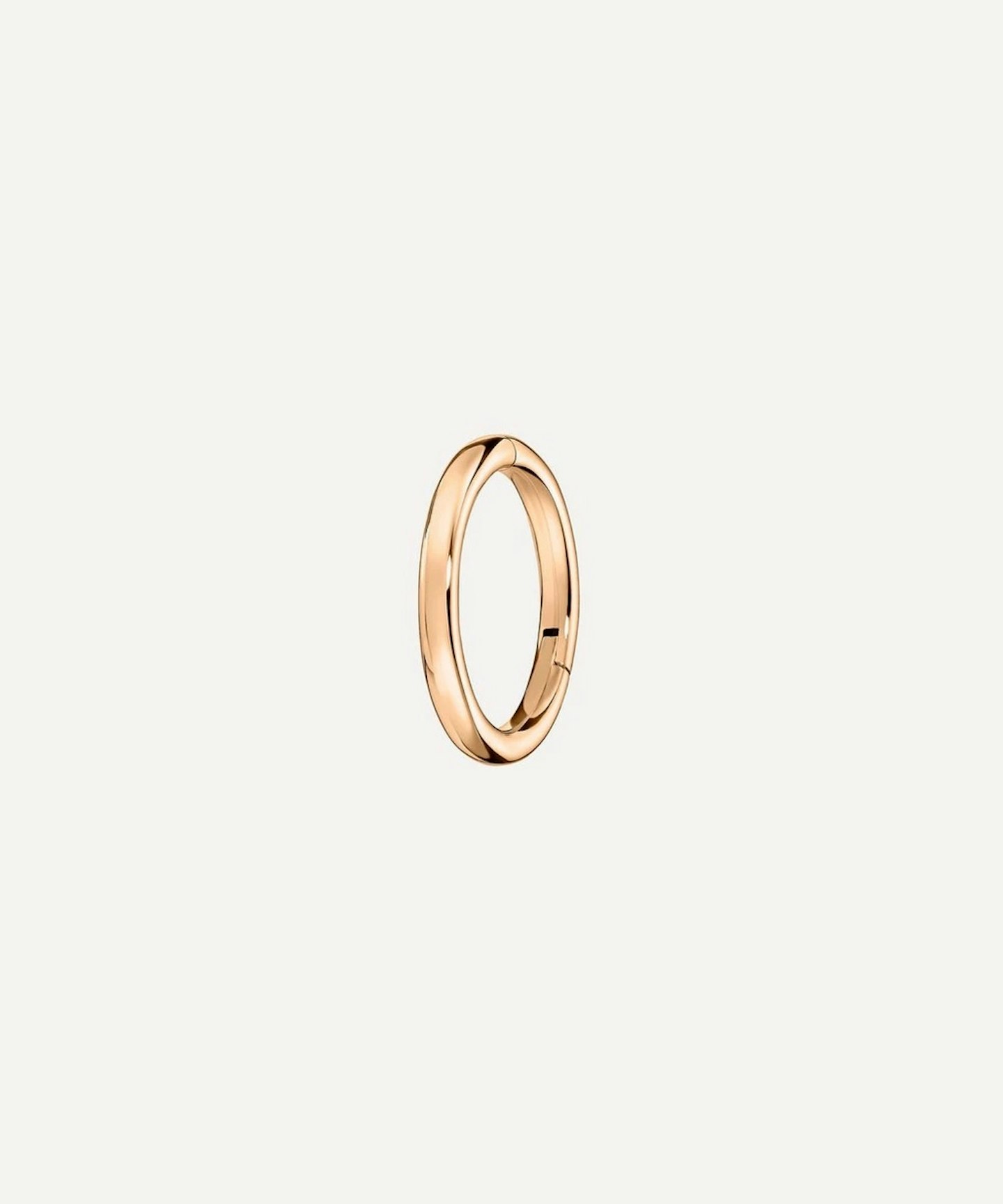
www.libertylondon.com
Once your rook has healed try switching out your stud for a 14ct rose gold hoop.
9. Industrial Piercing
These are any two piercings connected by a single barbell, and are also known as bar or scaffolding piercings. They enter the ear cartilage at two different points, typically around an inch and a half apart, and are always done with a needle, and never a gun. Stainless steel and titanium tend to be best for this piercing as they don't corrode, but aren't the right choice for those with a nickel allergy.
Pain level: 5/5
Healing time: 9 months to 1 year
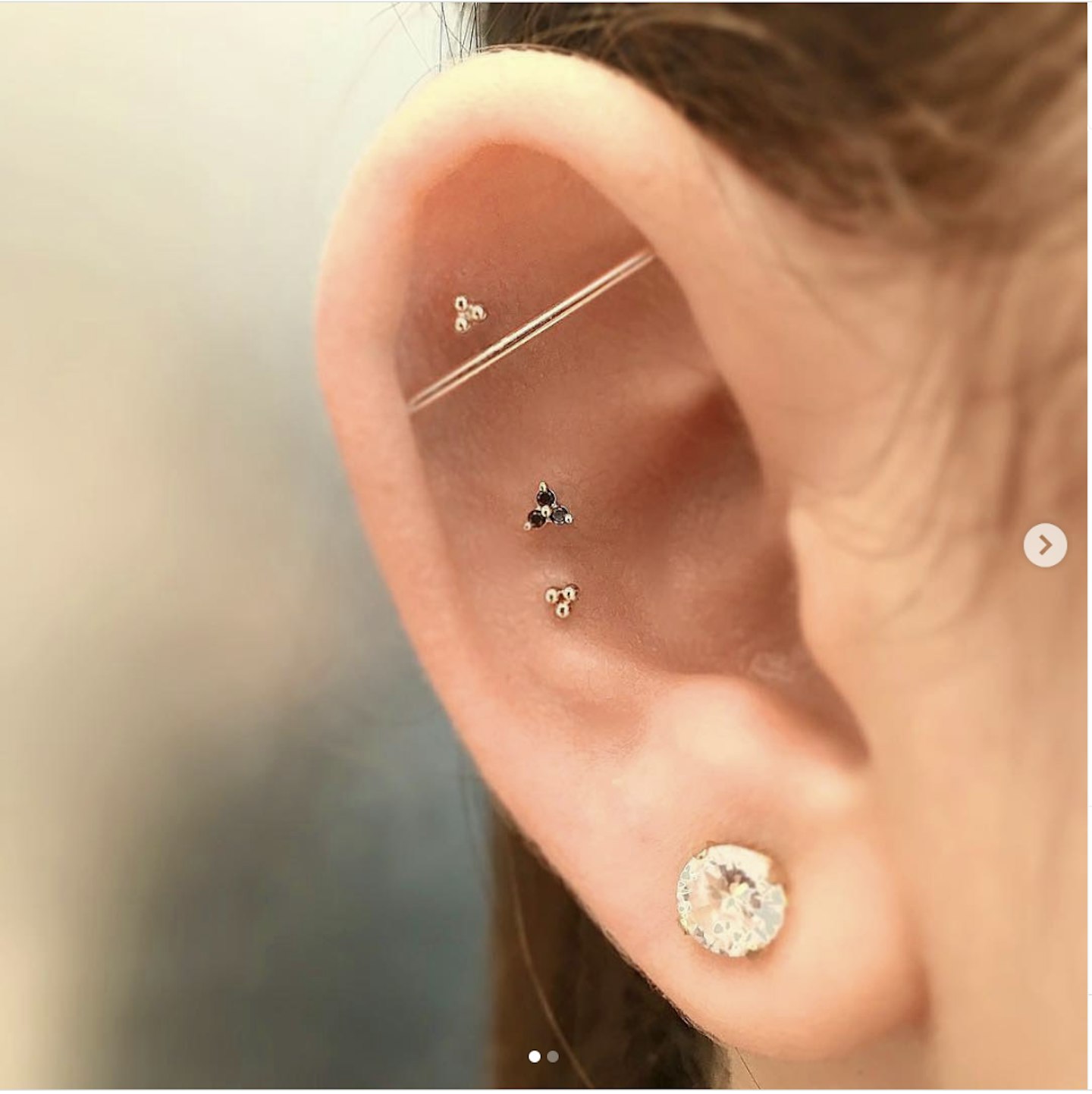
10. Contraconch
'The Contraconch sits on the arched section of the ear between the Conch and Helix,' says Tash. She also advises that if you are looking to accessorise this area effectively, look for smaller studs in this unique placement.
Pain level: 3/5
Healing time: 6-12 months

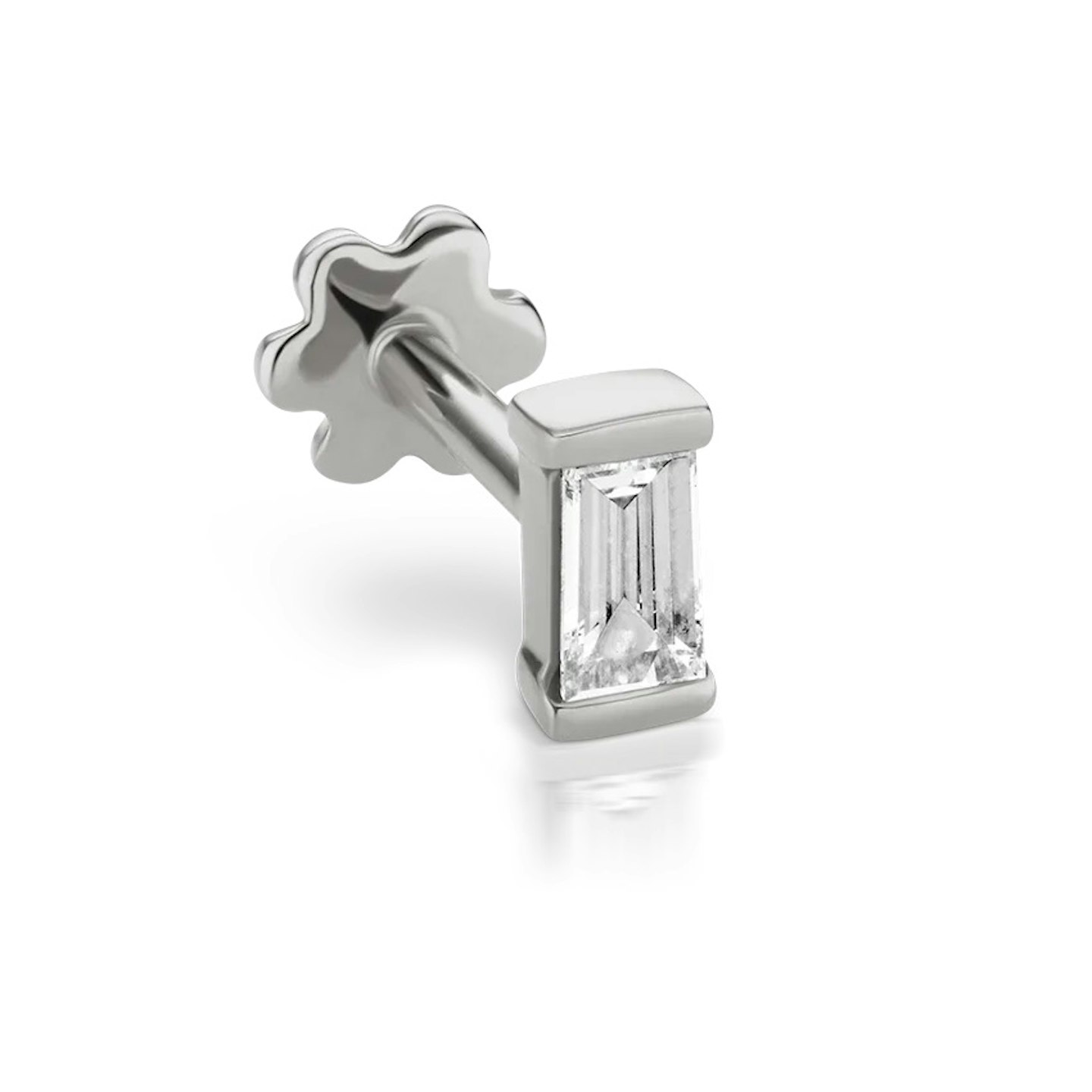
www.mariatash.com
Set in solid white gold, this baguette style diamond brings an elegant timelessness to an otherwise risqué look.
11. Tash Rook Piercings
Tash invented this piercing placement and explains that the Tash rook piercing is located on 'the large, flat plane of the upper ear above the Contraconch [and] is an ideal canvas to experiment with multiple piercings and stylings'.
Pain level: 5/5
Healing time: 3-10 months
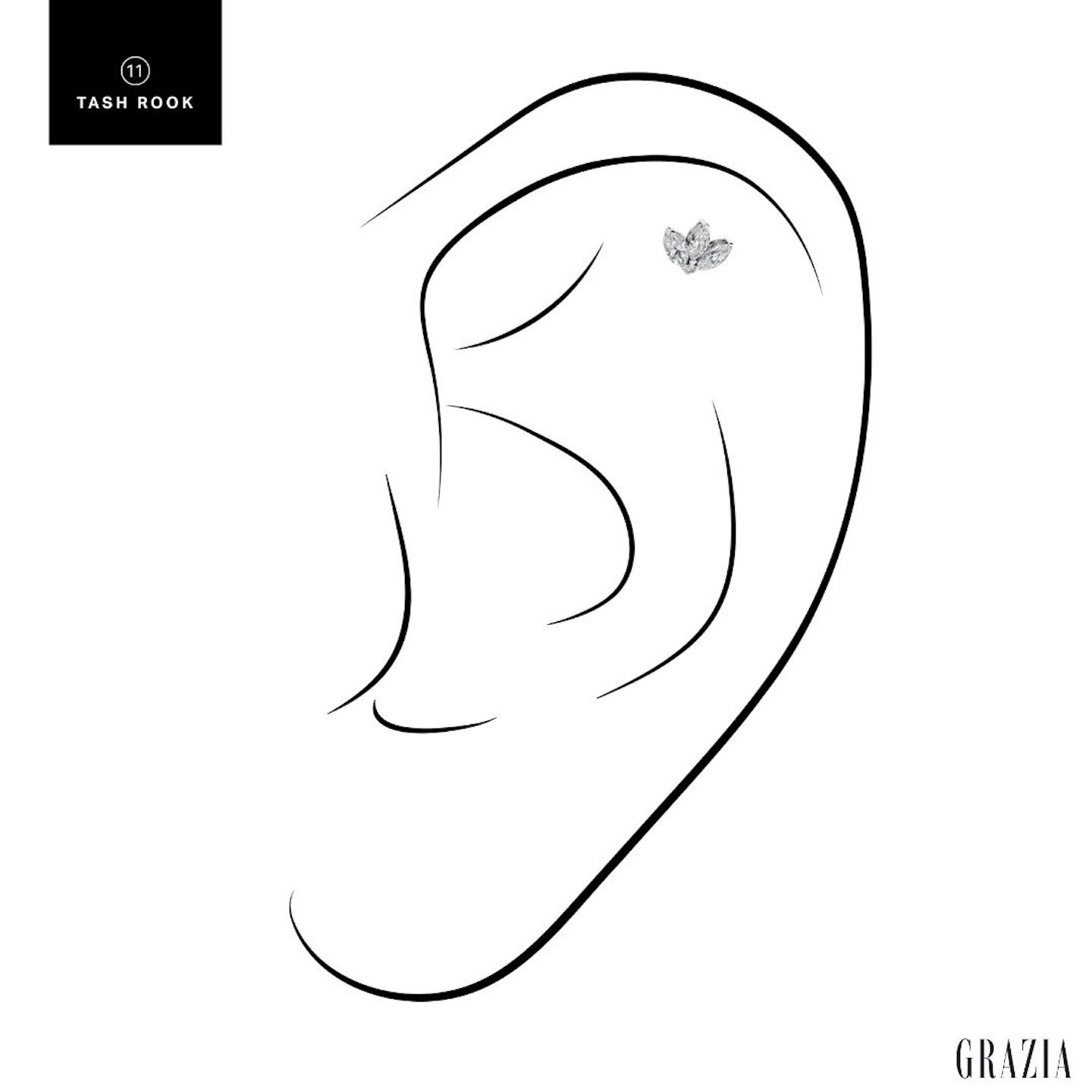
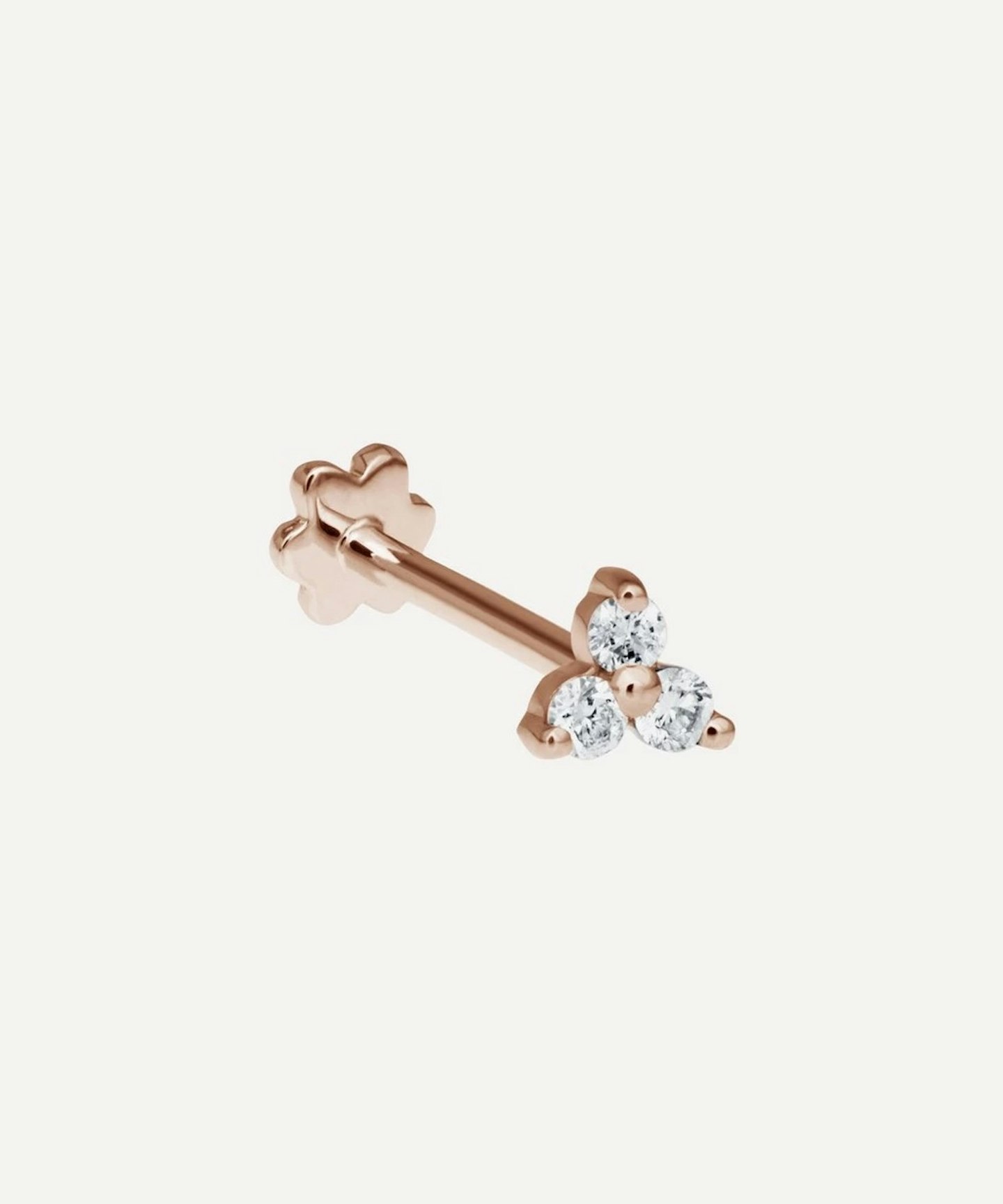
www.libertylondon.com
Featuring three round cut white diamonds this 18ct rose gold stud is a subtle way to dress up your Tash rook piercing.
12. Tash Hidden Rook℠
Another brain child of of Tash, the Tash Hidden Rook℠ is 'a hidden placement that sits under the rim of the Rook. The entry point and wearable components of our jewellery are tucked under the anatomy to create a “floating” look'. The clever style can appear almost unreal thanks to its positioning and will certainly make heads turn.
Pain level: 4/5
Healing time: 6-12 months
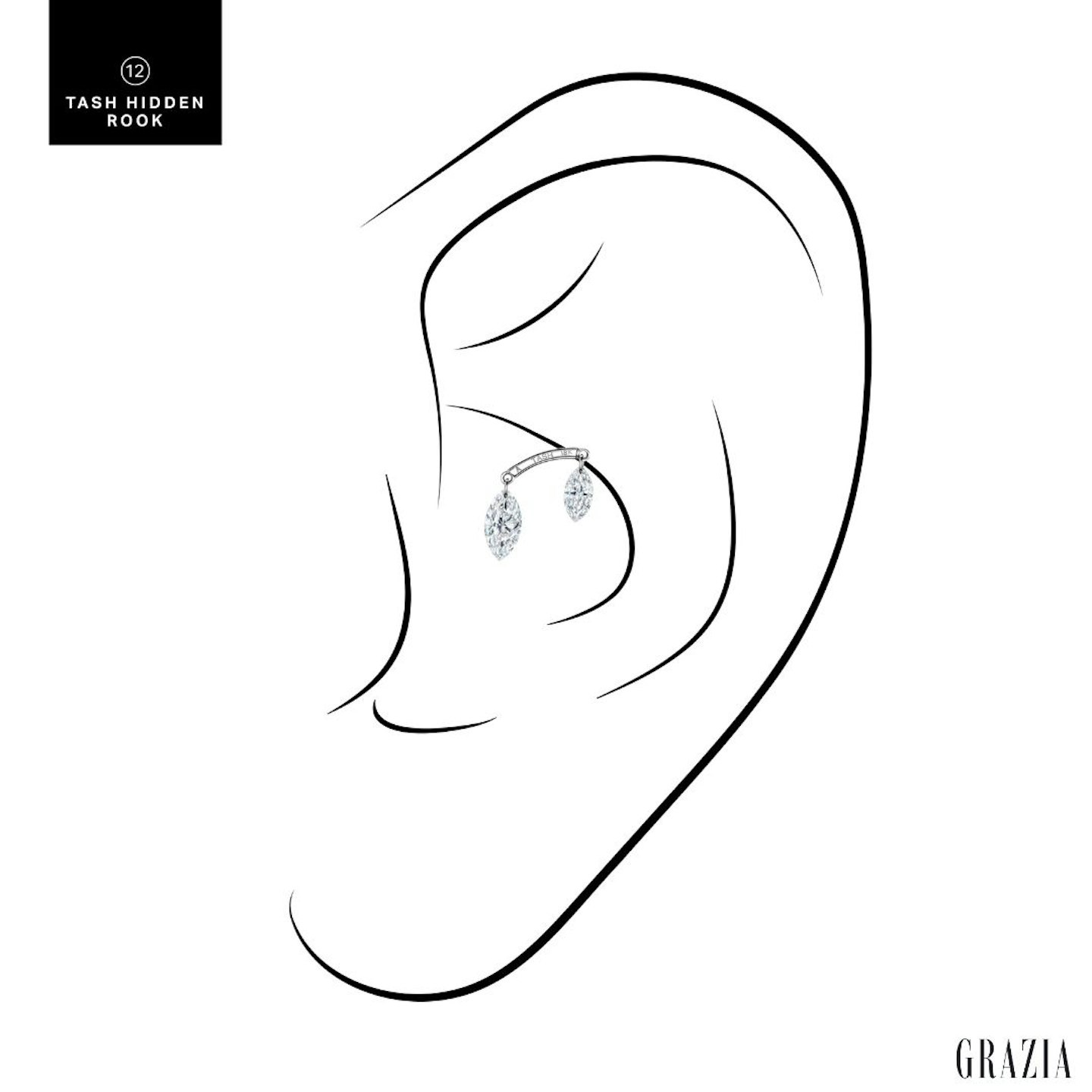
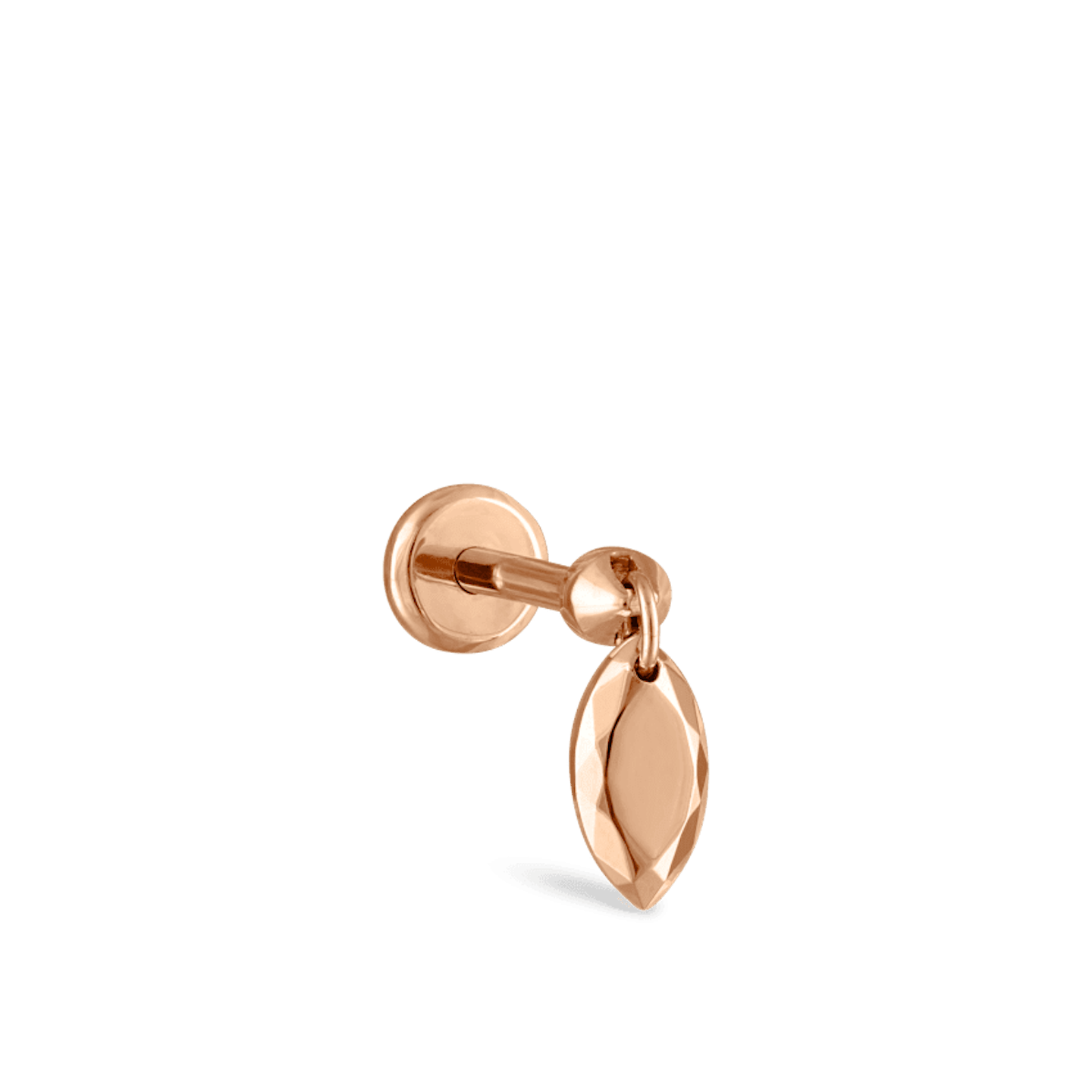
www.mariatash.com
This has been created purposefully to appear as if it's naturally float on the ear, making it a subtle and dainty addition to any earring set.
How To Clean Ear Piercings
Cleanliness is paramount to the health of your piercings. 'The best way to clean a piercing is to treat it gently, not torque it, and be very mindful of what touches it,' says Tash. 'The number one rule is not to touch the jewellery or piercing with dirty hands and it is important to remember the piercing is a minor wound that might take a few months to fully heal. The frequency of cleaning a piercing should be only twice per day until healed. Over-cleaning can create irritation.' Tash advises cleaning a fresh piercing with sterile saline.
How To Treat An Infected Ear Piercing
Getting a piercing will of course increase your risk of an infection because you’re creating a ‘wound’ of sorts. This is why it’s important to get it done professionally and in a pre-sterilised environment.
The aftercare is also an important part of making sure the piercing doesn’t get infected. Clean the piercing twice a day using a clean cotton bud and a sterile saline or antibacterial solution, and remove any dried blood or discharge with warm water. Don’t twist it though because this can irritate the piercing.
If your piercing is swollen, bleeding or painful and cleaning it regularly is not improving it, it could be infected, so consult a health professional or return to the piercer for advice. It’s rare for an ear piercing infection to spread to the rest of the body but, again, if you’re at all concerned about your piercing, consult a health professional.
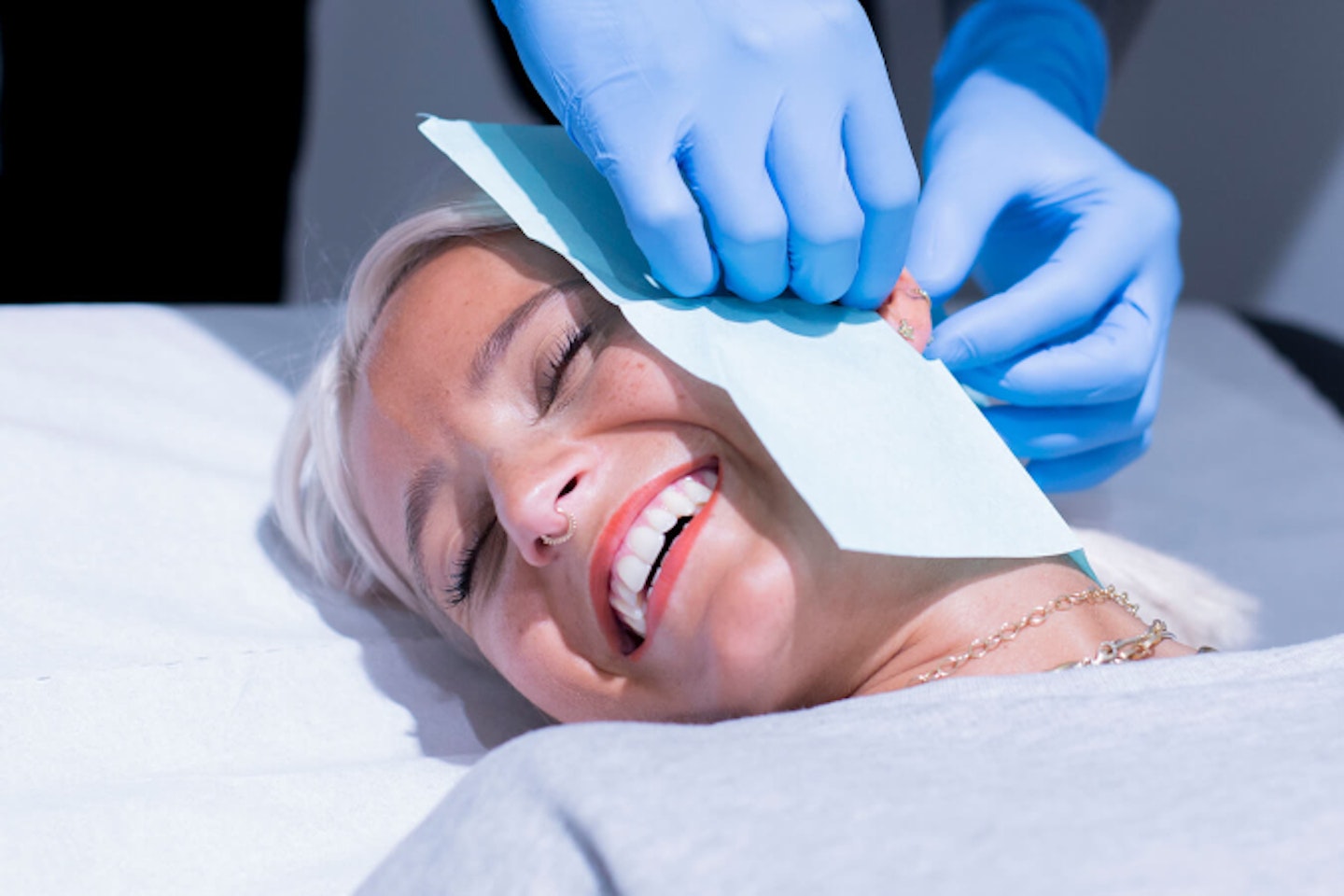
Do Ear Piercings Hurt?
First and foremost, the question we all want to know is - is this going to hurt me? This can be difficult to answer because it’s so subjective. Everyone has different pain thresholds, so something that hurts your friend might not even make you flinch. Generally, performing the piercing will hurt because you’re essentially putting a hole through your skin (it would be weird if it didn’t) so at the very least you should expect some kind of discomfort.
Different parts of the ear are bound to hurt more than others because the flesh varies - the ear lobe is generally considered the least painful piercing whereas cartilage piercings, like the helix, tragus, conch and so on – will usually be more painful because it’s tougher.
Jewellery brand Là Mood has created a chart that rates the pain factor for each different ear piercing. Well, an annotated photograph anyway. Check out it out below if you're wary of the pain factor and to find out which one most categorise as the most painful ear piercing to opt for:
How Much Do Ear Piercings Cost?
This really depends where you live, your budget and the piercing you're looking to get.
Best piercing shops on a budget: Claire’s and Accessorize both do earlobe piercings (first and second holes) on the high street and are super affordable so a good place to start. At Claire's across the UK, you can get lobe and cartilage piercings which start at £30 but this price can increase depending on the type of jewellery you opt for. Additionally, if you'd like your cartilage pierced there is an extra £4 charge.
Best upmarket piercing shop: For something a little more fashion, we recommend Astrid & Miyu, who have four piercing studios in London, as well as locations in Selfridges stores in London and Manchester. Their specially trained Ear Bar stylists will be able to help you create your own perfectly personalised ear, using your new and existing piercings and the brands dreamy earring selection.
Best piercing shop for a customised, high end experience: Head down to Maria Tash in Liberty and Harrods departments stores. Wherever you go, don't forget to look at reviews and certification to make sure you're getting pierced at a reputable place.
As for how much piercings cost, this depends on where you go, and also the part of the ear you’re having pierced. As a general rule, cartilage piercings will cost more (around £20-£30 and above) while ear lobes tend to be £15-£20 but it does vary and the type of jewellery you choose will also effect the price.
If you are wondering which method of piercing is best, that being a gun or needle, that will again depend on the area of the body being pierced. There is some debate around the use of ear piercing stud guns. In the British Body Piercing Association's code of practice and ethics it states: 'To only use the Gun method, for piercing ear lobes' - so be sure to stick with a piercing needle for any other body part, including any other part of the ear.
Hazel, AKA the Botanical Piercersays, 'A piercing is best performed with a piercing needle and most ear piercings should be pierced initially with a flatback labret as hoops can cause too much movement in a fresh piercing.'

Can Ear Piercing Help Migraines?
It’s been reported that a daith piercing can help reduce migraines because it hits a particular pressure point, meaning it's often touted as long-term acupuncture. It’s by no means scientifically proven, although many people have reported the positive side effects.
Main image: Instagram Maria Tash @mariatash
Sameeha Shaikh is Grazia UK's Beauty Writer, working across all categories to bring you insights on the latest trends, industry news and the products you need to know about, viral or not (most probably viral).
